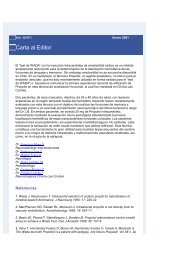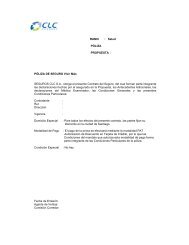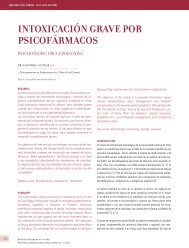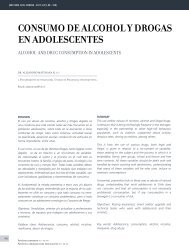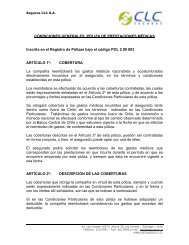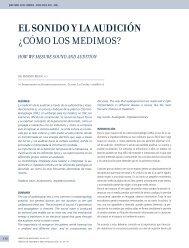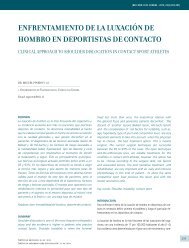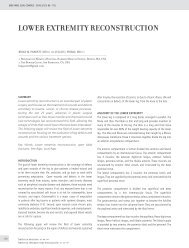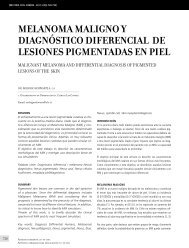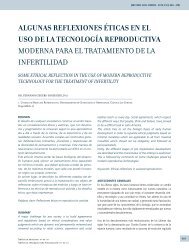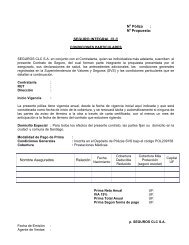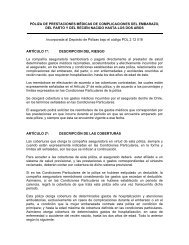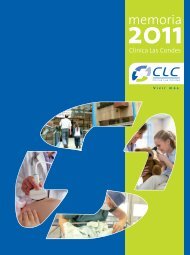Hijos adultos mayores al cuidado de sus padres, un fenómeno ...
Hijos adultos mayores al cuidado de sus padres, un fenómeno ...
Hijos adultos mayores al cuidado de sus padres, un fenómeno ...
You also want an ePaper? Increase the reach of your titles
YUMPU automatically turns print PDFs into web optimized ePapers that Google loves.
[REV. MED. CLIN. CONDES - 2012; 23(1) 58-64]<br />
buscarse marcadores más sensibles y precoces <strong>de</strong> injuria ren<strong>al</strong>, como la<br />
Cistatina C.<br />
Por otra parte, el adulto mayor tiene disminuida la capacidad <strong>de</strong> excretar<br />
<strong>un</strong>a sobrecarga aguda <strong>de</strong> agua y sodio, siendo más proclives a la hiponatremia,<br />
que pue<strong>de</strong> ser a<strong>de</strong>más favorecida <strong>de</strong> forma iatrogénica, como<br />
consecuencia <strong>de</strong>l uso frecuente <strong>de</strong> diuréticos en esta población.<br />
Consi<strong>de</strong>raciones farmacológicas<br />
La <strong>de</strong>snutrición c<strong>al</strong>órico - proteica es común en el paciente mayor. Existe<br />
evi<strong>de</strong>ncia a<strong>de</strong>más <strong>de</strong> la disminución <strong>de</strong>l agua corpor<strong>al</strong> tot<strong>al</strong> con la edad.<br />
Estos y otros factores llevan a la ten<strong>de</strong>ncia gener<strong>al</strong> <strong>de</strong> disminución en<br />
los volúmenes <strong>de</strong> distribución.<br />
Hay que sumar a lo anterior, la ten<strong>de</strong>ncia a la <strong>de</strong>clinación en el clearence<br />
ren<strong>al</strong> y hepático, lo que lleva a la prolongación <strong>de</strong> la vida media <strong>de</strong> <strong>al</strong>g<strong>un</strong>os<br />
fármacos, por lo que es imprescindible la consecuente necesidad <strong>de</strong><br />
ajustar las dosis <strong>de</strong> fármacos en forma individu<strong>al</strong>, ya sea dosis <strong>de</strong> carga<br />
y/o <strong>de</strong> mantención.<br />
En consi<strong>de</strong>ración a lo anterior, en nuestra <strong>un</strong>idad contamos con <strong>un</strong><br />
equipo multidisciplinario, en el que juega <strong>un</strong> rol relevante el Farmacista<br />
Clínico.<br />
Sistema inm<strong>un</strong>e<br />
Estudios <strong>de</strong>muestran que sobre los 65 años, las células madres hematopoyéticas,<br />
producen menos linfocitos y más células mieloi<strong>de</strong>s. Los glóbulos<br />
blancos son a<strong>de</strong>más menos eficientes y no logran respon<strong>de</strong>r a las <strong>de</strong>mandas<br />
<strong>de</strong> inm<strong>un</strong>idad que les exige el organismo, lo que contribuiría a<br />
facilitar la aparición <strong>de</strong> enfermeda<strong>de</strong>s infecciosas y otras hematológicas.<br />
Comentario fin<strong>al</strong><br />
Po<strong>de</strong>mos <strong>de</strong>cir que la edad en forma in<strong>de</strong>pendiente parece jugar <strong>un</strong> rol<br />
cada vez menos importante a la hora <strong>de</strong> <strong>de</strong>cidir el ingreso a <strong>un</strong>a UTI.<br />
Para ello <strong>de</strong>ben ev<strong>al</strong>uarse otras variables como por ejemplo comorbilida<strong>de</strong>s<br />
y causa <strong>de</strong> internación. La edad avanzada sería <strong>un</strong> factor a consi<strong>de</strong>rar<br />
para generar <strong>un</strong> pronóstico acerca <strong>de</strong> cada paciente en particular.<br />
En nuestro estudio, si bien la mort<strong>al</strong>idad observada en <strong>adultos</strong> <strong>mayores</strong><br />
es mayor en comparación <strong>al</strong> grupo <strong>de</strong> menores <strong>de</strong> 65 años, <strong>de</strong>ntro <strong>de</strong><br />
aquél grupo no existen diferencias en las cifras entre cada rango etario.<br />
Mayores estudios <strong>de</strong>berían ser re<strong>al</strong>izados para an<strong>al</strong>izar otras variables<br />
caus<strong>al</strong>es <strong>de</strong> estos resultados.<br />
REFERENCIAS BIBLIOGRáFICAS<br />
1. Koruda MJ, Sheldon GF. Surgery in the aged. Adv Surg 1991;24:293– 331.<br />
2. Knaus WA, Wagner DP, Draper EA, Zimmerman JE, Bergner M, Bastos PG, et<br />
<strong>al</strong>. The APACHE III prognostic system. Risk prediction of hospit<strong>al</strong> mort<strong>al</strong>ity for<br />
critic<strong>al</strong>ly ill hospit<strong>al</strong>ized adults. Chest. 1991;100:1619-36.<br />
3. Iezzoni LI, ed. Risk Adjustment for Measuring He<strong>al</strong>th Care Outcomes. Ann<br />
Arbor: He<strong>al</strong>th Administration Pr; 1994.<br />
4. Goldman L, C<strong>al</strong><strong>de</strong>ra DL, Nussbaum SR, Southwick FS, Krogstad D, Murray<br />
B, et <strong>al</strong>. Multifactori<strong>al</strong> in<strong>de</strong>x of cardiac risk in non cardiac surgic<strong>al</strong> procedures.<br />
N Engl J Med. 1977;297:845-50.<br />
5. Weintraub WS, Craver JM, Cohen CL, Jones EL, Guyton RA. Influence of age<br />
on results of coronary artery surgery. Circulation. 1991;84 Suppl 3:226-35.<br />
6. Mary Beth Hamel, MD, MPH; Roger B. Davis, ScD; Joan M. Teno, MD, MS;<br />
William A. Knaus, MD; Joanne Lynn, MD; Frank Harrell Jr., PhD; et <strong>al</strong> for the<br />
SUPPORT Investigators. Ol<strong>de</strong>r Age, Aggressiveness of Care, and Surviv<strong>al</strong> for<br />
Seriously Ill, Hospit<strong>al</strong>ized Adults. Ann Intern Med. 1999;131:721-728.<br />
7. Angus DC, Kelly MA, Schmitz RJ, White A, Popovich J, for the committee<br />
on manpower for pulmonary and critic<strong>al</strong> care societies (COMPACCS) (2000)<br />
Current and projected workforce requirements for care of the critic<strong>al</strong>ly ill and<br />
patients with pulmonary disease: can we meet the requirements of an aging<br />
population? JAMA 284:2762–2770.<br />
8. E. Wesley Ely Optimizing outcomes for ol<strong>de</strong>r patients treated in the<br />
intensive care <strong>un</strong>it. Intensive Care Med (2003) 29:2112–2115.<br />
9. Ramesh Nagappan, Geoffrey Parkin. Geriatric critic<strong>al</strong> care. Crit Care Clin<br />
19 (2003) 253– 270.<br />
10. Kollef MH. Do age and gen<strong>de</strong>r influence outcome from mechanic<strong>al</strong><br />
ventilation. Heart L<strong>un</strong>g 1993;22:442–9.<br />
11. Ely EW, Wheeler AP, Thopson BT, et <strong>al</strong>. Recovery rate and prognosis in<br />
ol<strong>de</strong>r persons who <strong>de</strong>velop ALI and ARDS. Ann Intern Med 2002;136:25–36.<br />
Los autores <strong>de</strong>claran no tener conflictos <strong>de</strong> interés, en relación<br />
a este artículo.<br />
64



